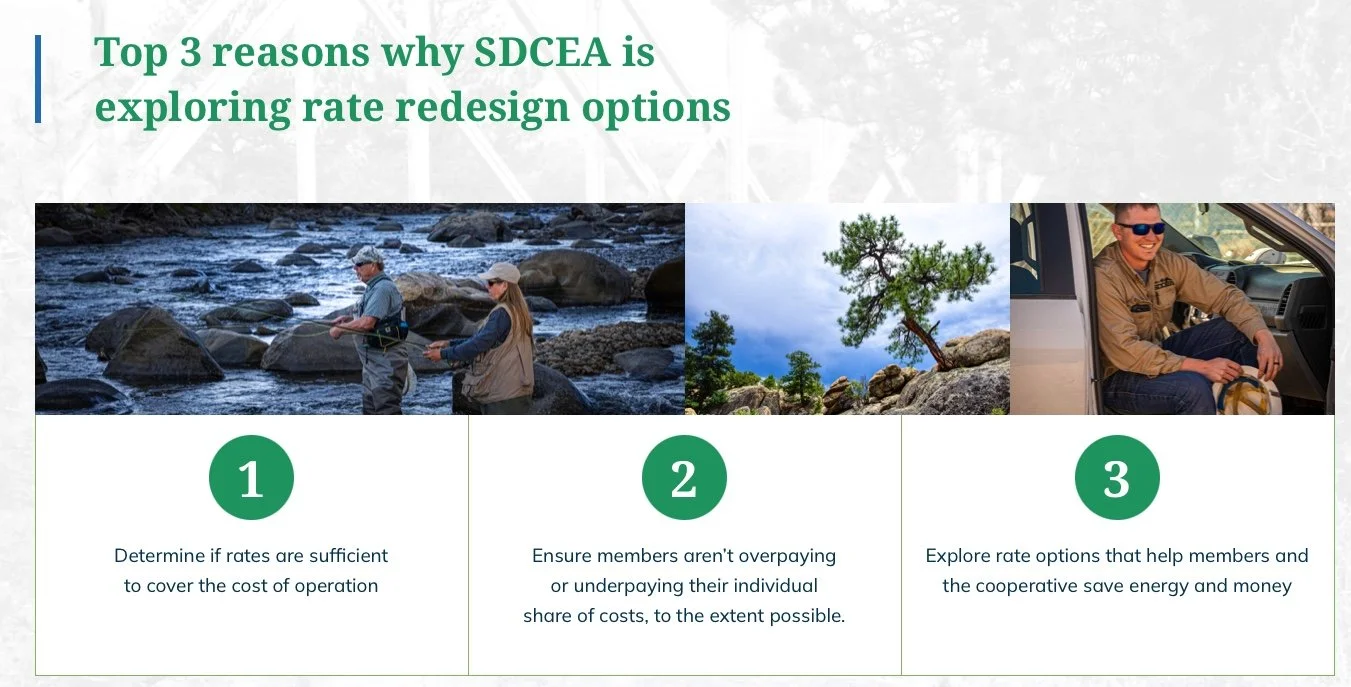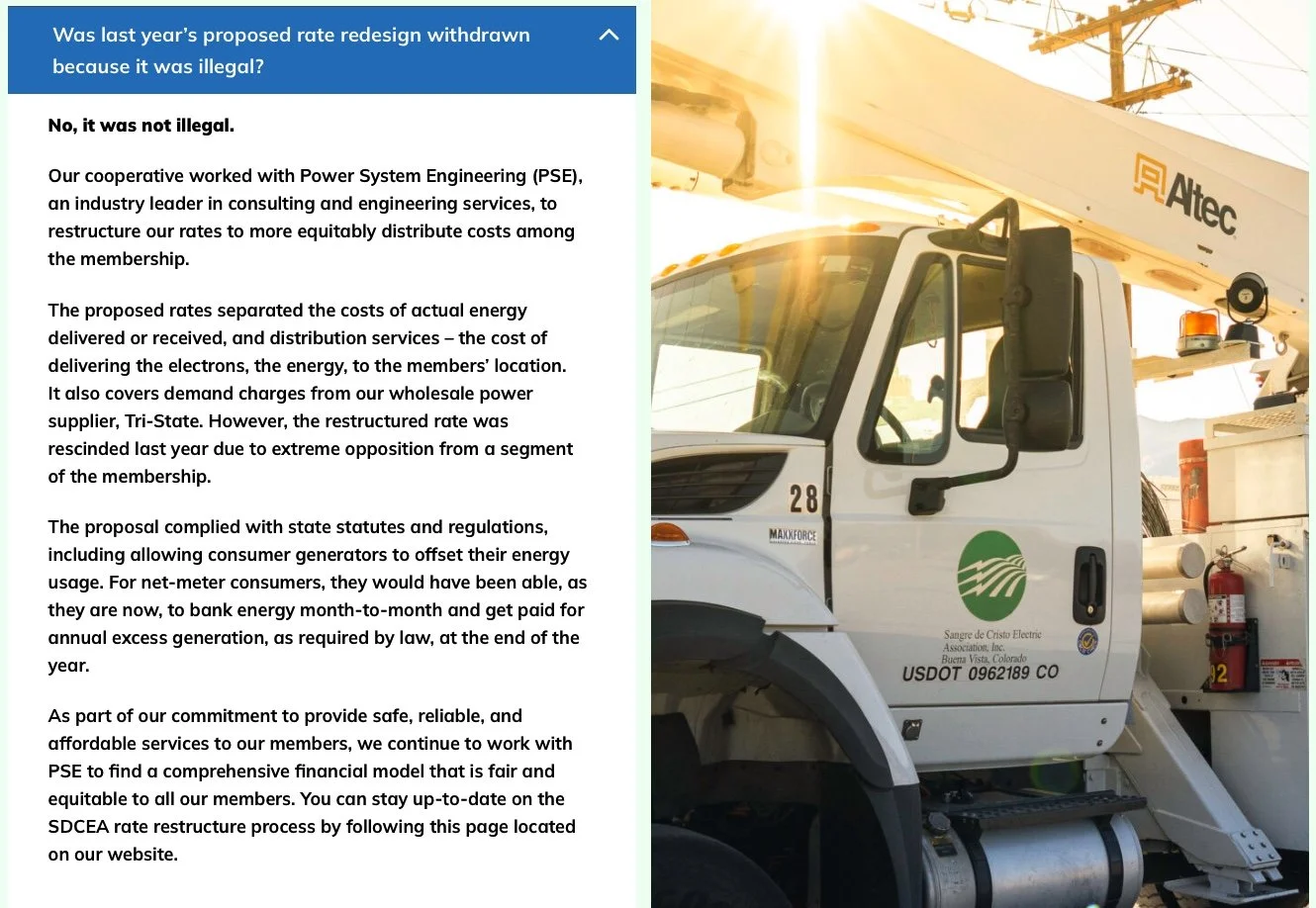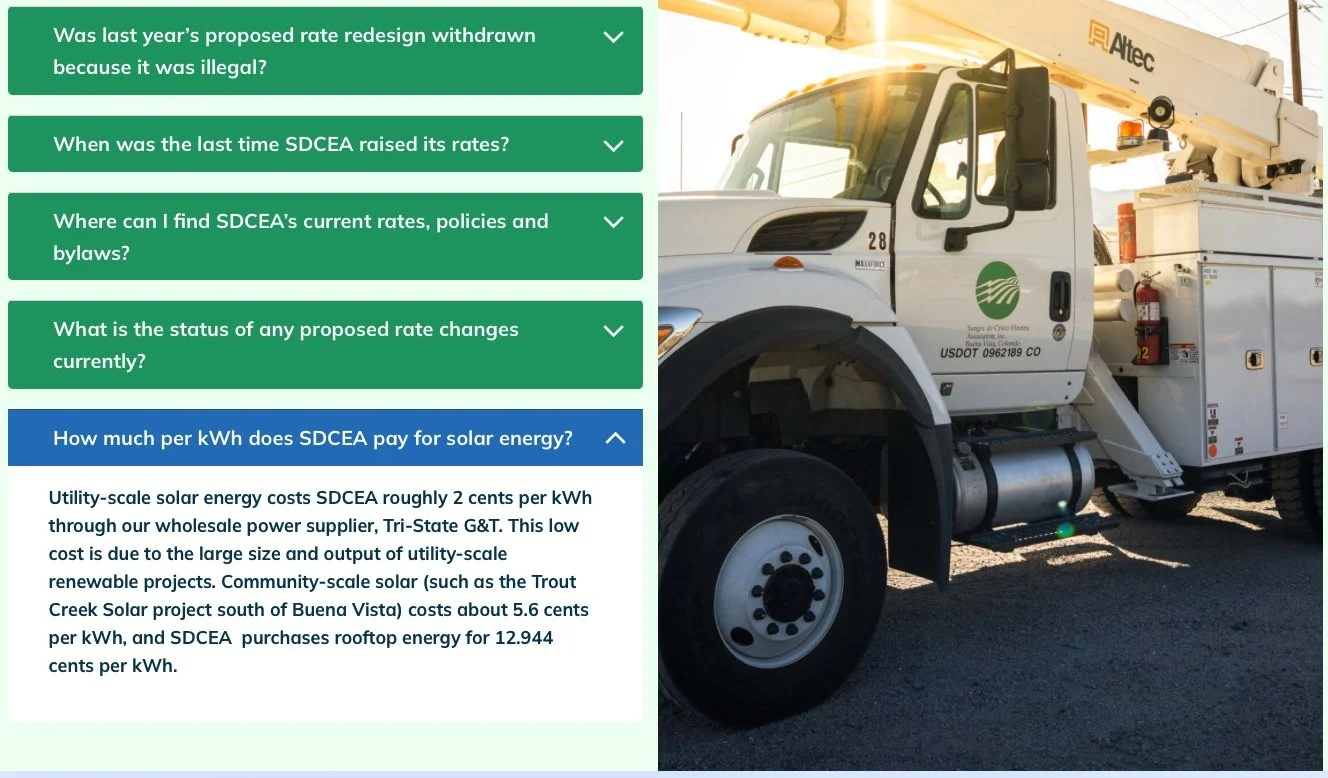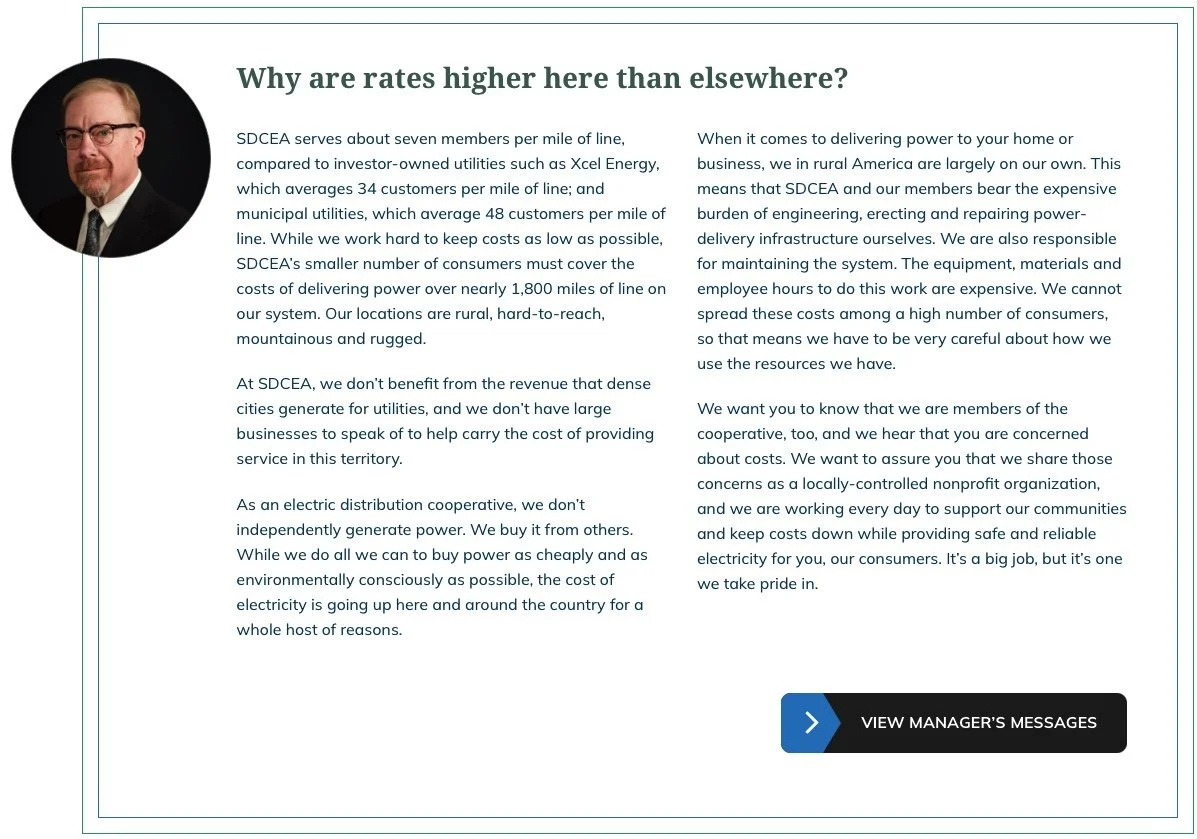
SDCEA has created a page called “Know the Facts” on their website. We will point out and clarify some of the misleading statements going screen by screen through the page on their website.
SDCEA SAYS:
AVEF SAYS:
Top 3 Reasons why SDCEA is exploring rate redesign options.
1 - Determine if rates are sufficient to cover the cost of operation
Rates are sufficient to cover the cost of operation - SDCEA actually collected nearly $1M more in rates in 2021 than it required to cover costs. This was returned to ratepayers through our “capital credits” - that is a credit you received on your bill in November for overpayment. The rate redesign has nothing to do with insufficient revenues. In fact, the rate redesign that SDCEA rolled out January 2022 was labeled as “revenue neutral”.
2 - Ensure members aren’t overpaying or underpaying their individual share of the costs, to the extent possible
This is certainly subject to interpretation and is a critical issue for the board to address. How does one define overpaying and underpaying? If a person uses 2,000 kWh/month should they pay for more of the infrastructure costs than if a person uses 200 kWh/month?
The SDCEA rate structure in the past has reflected the position that regardless of how much energy you use, you should pay the same for the infrastructure. This is reflected in SDCEA’s monthly fixed service charges. However, low income and fixed income users who typically use less electricity may not be able to pay the same amount for infrastructure through fixed charges as members who use more electricity. And perhaps it is not fair to expect them to.
Also, those who generate electricity and deliver it to the SDCEA system cost less to the co-op because their power is locally generated. In these instances, a case can be made that low use customers and people generating their own energy should not be expected to pay the same fixed charges as higher energy users.
Finally, high energy users drive significant costs to the grid in the form of upgraded transformers and other energy management infrastructure. For this reason, most utilities put a portion of the infrastructure costs in monthly fixed costs and another portion in the energy charge (price/kWh of consumption). For many utilities the monthly cost is just the incremental infrastructure costs that are directly attributable to providing service to that customer and shared infrastructure costs are built into the rate charge.
The approach that SDCEA has taken in the past is to push more and more of their infrastructure costs into the monthly fixed charge. But this means that effectively, low energy users are paying much higher per/kWh costs than high energy users, even though their burden on the grid is much less.
This is an area where SDCEA would do well to have open meetings where they can hear from their members and get expert input from outside of the utility and outside of the usual voices of NRECA (National Rural Electric Cooperative Association), Tristate and CREA (Colorado Rural Electric Association) and learn about innovations in rate design and cost allocation.
3 - Explore rate options that help members and the cooperative save energy and money
This is an honorable objective, but unfortunately the last “solution” that SDCEA developed penalized members for conserving energy by charging them more. The January 2022 proposed rate structure actually negated both objectives. AVEF is all for finding rate options that help members achieve their energy objectives. Maybe that’s more solar, maybe that’s a lower monthly fixed cost, maybe that’s greater energy efficiency, maybe that’s expanded energy services. The only way to determine member objectives is to engage with the membership. AVEF has proposed a number of measures SDCEA could employ to be able to hear directly from the membership, but so far, SDCEA has not shown a willingness to do this.
SDCEA SAYS:
AVEF SAYS:
Was last year’s proposed rate redesign withdrawn because it was illegal?
We have no way of knowing what the discussions were around the withdrawal of the January 2022 rate restructuring because those discussions did not happen in public. However, the illegality of the net metering provisions were discussed multiple times with the board members and we certainly hope it was withdrawn because it was illegal.
Here, SDCEA claims the net metering redesign was not illegal because members could bank their energy month-to-month and be compensated at the end of the year as required by law. While those are indeed portions of the law, they do not represent the law in its entirety (see the entire net metering law below). The law is very clear and SDCEA’s proposed Net Metering change was indeed in violation of the law.
Colorado’s Net Metering Statute:
Title 40 - Utilities, Public Utilities Article 9.5 - Cooperative Electric Associations
Part 1 - Generally § 40-9.5-118. Net metering - rules
Universal Citation: CO Rev Stat § 40-9.5-118 (2016)
(1) Definitions. For purposes of this section, unless the context otherwise requires:
(a) "Customer-generator" means an end-use electricity customer that generates electricity on the customer's side of the meter using eligible energy resources.
(b) "Eligible energy resources" has the meaning established in section 40-2-124.
(2) Each cooperative electric association shall allow a customer-generator's retail electricity consumption to be offset by the electricity generated from eligible energy resources on the customer-generator's side of the meter that are interconnected with the facilities of the cooperative electric association, subject to the following:
(a) Monthly excess generation. If a customer-generator generates electricity in excess of the customer-generator's monthly consumption, all such excess energy, expressed in kilowatt-hours, shall be carried forward from month to month and credited at a ratio of one to one against the customer-generator's energy consumption, expressed in kilowatt-hours, in subsequent months.
(b) Annual excess generation. Within sixty days after the end of each annual period, or within sixty days after the customer-generator terminates its retail service, the cooperative electric association shall account for any excess energy generation, expressed in kilowatt-hours, accrued by the customer-generator and shall credit such excess generation to the customer-generator in a manner deemed appropriate by the cooperative electric association.
(c) Nondiscriminatory rates. A cooperative electric association shall provide net metering service at nondiscriminatory rates.
(d) Interconnection standards. A cooperative electric association and a customer-generator shall comply with the interconnection standards and insurance requirements established in the rules promulgated by the public utilities commission pursuant to section 40-2-124; except that the cooperative electric association may reduce or waive any of the insurance requirements, and except that the public utilities commission shall initiate a rule-making proceeding no later than October 1, 2008, for the purpose of addressing cooperative electric association system issues in its small generator interconnection procedures. A cooperative electric association shall not prevent or unreasonably burden the installation of a net metering system if such system includes protective equipment that prevents any export of customer-generated electricity from the customer's side of the meter.
(e) (I) Size specifications. Each cooperative electric association shall allow:
(A) Residential customer-generators to generate electricity subject to net metering up to ten kilowatts; and
(B) Commercial or industrial customer-generators to generate electricity subject to net metering up to twenty-five kilowatts.
(II) Each cooperative electric association may allow customer-generators to generate electricity subject to net metering in amounts in excess of the minimum amounts specified in subparagraph (I) of this paragraph (e). If the cooperative electric association denies interconnection to a customer-generator that has requested interconnection of a system with a capacity of twenty-five kilowatts or larger, the association shall provide a written technical or economic explanation of such denial to the customer.
Why SDCEA’s proposed shift to Net Billing from Net Metering is illegal.
As you can see in the Colorado net metering statute, the state’s requirement for net metering is reiterated in a few different ways. Net metering is a one-to-one credit for kWh produced and delivered to the grid against a kWh taken off of the grid. The customer-generator only pays for the kWh above that net.
This is stated very clearly in paragraph (2)(a): “credited at a ratio of one to one against the customer-generator’s energy consumption expressed in kilowatt-hours”. It is also stated above in the main paragraph (2): “shall allow a customer-generator’s retail electricity consumption to be offset by the electricity generated from eligible energy resources”
So, if you generate solar electricity at your home and put that power on the grid, you are credited one-to-one for the kWh you put on the grid against the kWh you take off the grid. That is net metering.
SDCEA’s proposed change was to charge you an additional fee for “distribution costs” for any power pulled off the grid. This is a violation of the law in one of two ways: 1) either it is not crediting the full kWh at the retail value as is required by statute, or 2) it is crediting at the one-to-one rate and then adding an additional charge, which is a discriminatory rate to net metered customers and prohibited in (2)(c): “A cooperative electric association shall provide net metering service at nondiscriminatory rates”.
What SDCEA was proposing with the rate change is called “Net Billing”. With net billing, the customer pays an extra charge determined by the utility, which reflects what they view as the difference between the value of the self-generated kWh compared to the value of the kWh the customer takes off the grid. Net Metering is based on the meter and not on the “value” the utility assigns to the energy the coop member self-produced. Net billing is very much subject to interpretation and that’s why it was made illegal in Colorado. Net Metering is clear and easily understood - a kWh from the customer equals a kWh from the utility. Net Billing exists in states that do not have a Net Metering requirement in statute as Colorado does. This is why the proposed shift from net metering to net billing was illegal.
SDCEA SAYS:
AVEF SAYS:
How much per kWh does SDCEA pay for solar energy?
What SDCEA is describing here is what Tri-State Generation and Transmission pays for utility scale solar electricity, not what SDCEA pays. In fact, Tri-State owns or purchases a portfolio of resources that cost differing amounts. Some are impacted by fuel costs (for example coal and natural gas) and others are based on what are called Power Purchase Agreements (PPAs). At the end of the day, the electricity that is delivered to SDCEA is a collection of all the electrons produced by Tri-State’s full portfolio of resources. SDCEA does not buy utility scale solar by itself, they buy electricity that is from a variety of sources.
How much do they pay for that electricity? Tri-State reports in their annual report to the Security and Exchange Commission (SEC) that they sell their electricity at a wholesale rate of 7.408 cents/kWh. When pressed on this issue, SDCEA disputes this by saying “it’s complicated” but doesn’t provide any information to clearly articulate what the price of electricity is. We know one thing - it is not 2 cents/kWh. This claim by SDCEA is misleading and they owe it to the member-owners to clearly explain what their purchase price of electricity is from Tri-State.
In addition, SDCEA says they purchase rooftop solar for 12.944 cents/kWh. However in actuality, SDCEA purchases rooftop solar for much less than that, about 2 cents/kWh. The only time that SDCEA purchases rooftop solar from customer-generators is when they buy excess production from their members at the end of the year. This is called a “true-up”. This is after they have already sold the solar power for 12.9¢/kWh to other customers and at no cost to the cooperative (a net benefit to the cooperative of 11¢/kWh). They are required by law to carry forward kWh credits from month-to-month, but are allowed to true-up at the end of the year “in a manner deemed appropriate by the cooperative electric association”. The coop deems a year-end true-up at about 2 cents per kWh as “appropriate”. Other electric cooperatives allow their net metering customers to carry their generation credits through the coldest winter months and true-up in March or April, or carry forward credits indefinitely (Xcel). SDCEA’s compensation for solar producers is the lowest in the state. SDCEA pays about 2 cents/kWh to solar customers and their claim that they pay 12.944 cents/kWh for rooftop solar is misleading.
SDCEA SAYS:
AVEF SAYS:
Why are rates higher here than elsewhere?
We don’t know the answer to this because we don’t have access to all of the information that would be needed to determine the answer. But we would wholeheartedly endorse an effort by the SDCEA board to hire an outside utility auditor to get to the bottom of this question.
Here is what SDCEA’s Know the Facts page says with our clarification below each point:
SDCEA serves about 7.5 members per mile. The Colorado Rural Electric Association reports that the average for electric cooperatives in Colorado is 7.9 members per mile. So we are slightly below the average in customers per mile, but we are still the most expensive cooperative in the state. So, the average member/customers per mile doesn’t explain the high rates.
We don’t have large businesses to help carry the cost of providing service in this territory. This is hardly unique among rural cooperatives, but it is true that different cooperatives serve different communities that have different types of businesses. Sometimes those businesses actually drive higher costs in infrastructure upgrades that are required. We can’t say if this has a meaningful impact on our rates and how they compare with other cooperatives. We don’t see any evidence that this is the reason for higher rates.
We don’t independently generate power and the cost of power is going up here and around the country for a whole host of reasons. Again, this is not unique for distribution cooperatives. SDCEA is under contract with Tri-State Generation and Transmission to purchase 95% of our power from Tri-State, as are almost all other cooperatives in Colorado, but we are still more expensive than other coops. There are other cooperatives served by Tri-State that are under a “partial requirements” contract allowing them to shop around for less expensive power or generate more power themselves. These cooperatives are seeing decreases in their costs - with savings being passed on to their members. Tri-State has said that their increased investment in renewables is allowing them to lower their wholesale rate for member cooperatives by 7%. Tri-State’s Security and Exchange Commission (SEC) filing shows that rates have gone from 7.544 cents/kWh in 2017 to 7.408 cents/kWh in 2021 - So, the cost of power does not appear, in general, to be going up as SDCEA claims here.




